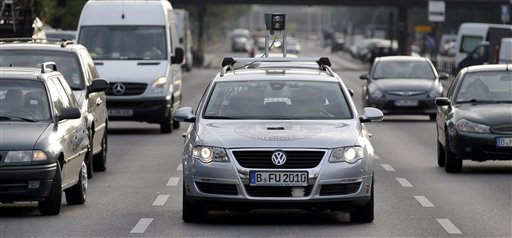 Berlin, Germany – It can talk, see, drive and no longer needs a human being to control it by remote. The car of the future — completely computer-controlled — is on the streets of Berlin.
Berlin, Germany – It can talk, see, drive and no longer needs a human being to control it by remote. The car of the future — completely computer-controlled — is on the streets of Berlin.
Subscribe to our Daily Roundup Email
All summer, researchers from the city’s Free University have been testing the automobile around the German capital.
The vehicle maneuvers through traffic on its own using a sophisticated combination of devices, including a computer, electronics and a precision satellite navigation system in the trunk, a camera in the front, and laser scanners on the roof and around the front and rear bumpers.

“The vehicle can recognize other cars on the road, pedestrians, buildings and trees up to 70 meters (yards) around it and even see if the traffic lights ahead are red or green and react accordingly,” Raul Rojas, the head of the university’s research group for artificial intelligence, told reporters at a presentation Friday.
“In fact, the car’s recognition and reaction to its environment is much faster than a human being’s reaction.”
The scientists have worked on their research car, a Volkswagen Passat worth euro400,000 ($551,800) with lots of built-in special technology, for four years.
Several other groups have also been working on such technology recently, notably Google, which has been testing a robotic Toyota Prius in Nevada.
“There’s a big trend for completely computer-controlled cars — many companies and research centers in several countries are working on it and it is hard to say, who’s got the most-developed vehicle at the moment,” Ferdinand Dudenhoeffer, a professor for automotive economics at the University of Duisburg-Essen, told The Associated Press on Tuesday.
Dudenhoeffer estimated that with the technology advances, it could only take another decade for the fully automatic cars to start becoming available for consumers. “Even today’s cars are often partially computer-controlled, for example when it comes to parking or emergency brakes.”

However, he said, that besides the technological issues, the legal challenges would be another issue that needed to be regulated: “Who will be responsible when there’s an accident — the owner or the passenger of the computer-controlled car or the company that produced it?”
“However, all in all, one can definitely say that computer-controlled cares will be much safer than human drivers,” Dudenhoeffer said. “Especially if you keep in mind that most of today’s accidents are caused by human error.”
In Berlin, the university researchers received a special permit from the city’s security and safety controllers in June to use it in regular traffic — under the condition that a safety driver sits behind the steering wheel, even if he doesn’t touch anything — not the steering wheel, gas pedals nor brakes.
On a special testing ground, the team has also been allowed to let the car run without anyone on board.
“This kind of technology is the future of mobility,” Rojas said, who had a more conservative estimate than Dudenhoeffer, saying that it may be 30 to 40 years before they become available to the average consumer.
The key to the automobile’s intelligence is in the way the computer program runs.

“In the beginning with had trouble with the robotic driving style of the car,” said Rojas. “But we’ve worked on the programming and now its driving style is as smooth as a human being.”
Rojas estimates that once the technology — specifically the sensors — gets less expensive, such cars will eventually conquer the roads.
“It is similar to the beginnings of the computers: 40 years ago, only research labs could afford computers, now everybody is walking around with a computer in his pocket.”
Ideally, the car will respond to orders by remote control, for example on an iPad or an iPhone. With a click or a touch, the passenger can call the car to his personal location and then order the car to drop him off at his desired destination.
“This kind of car is actually perfect for car sharing,” said Rojas. “There will be no more need for owning a car — once the automobile has dropped off its passenger it will drive on to the next passenger.”

A big lamdim and brilliant computer scientist A’H was working at the University of Maryland on the same principle. Soon pilots will fly out the window too. This is the root cause of the unemployment automation with no need of humans
When I see it rolling down 13th Avenue in Boro Park on Erev Shabbos or Erev Yom Tov without colliding with anything or anyone, then I will believe it.
It will save lives if drunks can use this technology to get home safely from a bar.
So where does the “CAR” have to go if no one is in it?
Good bye for the expensive airport parking fees, whenever I go to London, my car will drop me off in the airport then ‘it’ will drive back to my house in Boro Park.. And of course ‘it’ will pick me up from the airport when I return..
Gee! ‘It’ will change parking spaces according to alternate side..
How about this:
Sorry the computer was down
Who needs Obama now? Robot car can do it all better. Put ‘im on the next ballot!